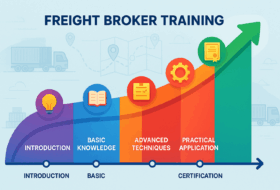Welcome to an in-depth look at the operational side of the trucking industry, drawing insights from Anis, the owner and dispatcher of a small trucking company. In this post, we dive into the truck dispatcher daily tasks, challenges, and strategies employed to keep trucks moving and the business running smoothly.
Anis manages a small operation with four trucks, including two company trucks and two owner-operators. He handles all aspects of the business, from dispatching and payroll to other administrative duties. Having driven trucks himself for nearly a decade and owned the business for about eight years, Anis offers a perspective shaped by experience on all sides of the industry. This post is based on his real-world account of a typical day, offering practical tips and a look behind the scenes.
The Dispatcher’s Day: Finding and Booking Loads
A typical day for a trucking dispatcher often starts early, particularly for those on the East Coast, with activity beginning around 8 a.m. Anis tries to get ahead by starting as early as 7 a.m., as the best time to book loads is usually between 7 and 10 a.m. While not every place posts loads that early, it happens often enough to make starting at 7 a.m. worthwhile.
The primary focus of the day, and the most critical task that drives the business, is finding loads. Dispatchers spend a significant portion of their time searching for suitable freight for their trucks. Anis uses a simple Google Sheets spreadsheet as a load board to track where each truck is going and identify which ones need loads. This digital board, evolved from an old-fashioned wall whiteboard, allows Anis and potentially other dispatchers (in a larger company context) to share and update information in real-time, even remotely.
Using Load Boards and Identifying Opportunities
Anis relies heavily on the DAT board, describing it as “the mother of all load boards” and the source for 99% of loads posted online. When a truck needs a load, Anis posts its availability on the DAT board, specifying origin, destination preferences, date, weight, and length. He sets search parameters like pickup radius (e.g., 100-150 miles) and filters for full loads, as partial loads can be more complex to manage.
Searching the DAT board reveals potential loads with details like pickup location, destination, mileage (often calculated via the broker’s preferred route, which might differ from actual driving routes like avoiding Canada), weight, and pickup/delivery times. Anis looks for lighter loads (e.g., 13,000 lbs) as they are easier on the truck and consume less fuel. He also checks comments for specific load information.
A Truck Dispatcher’s Day: Broker Communication and Negotiation
Once potential loads are identified, the next step is contacting the broker. Anis demonstrated calling a broker about a load from Grand Rapids, MI to Warners, NY. The conversation involves confirming details like the shipper name and the posted rate. Negotiation is a key part of the process; Anis asked for $2800 for a load posted at $2560, knowing they would likely settle somewhere in the middle. The broker counter-offered $2700, which Anis accepted after confirming with the owner-operator driver. This negotiation highlights the dynamic nature of freight rates and the dispatcher’s role in maximizing revenue.
Broker Relationships and Payment Processing
Booking a load with a new broker involves a setup process where the broker sends a packet of paperwork. This packet includes legal documents, requiring information like the trucking company’s insurance, authority, permits, and references. Anis checks new brokers using resources like the free website Broker Credit Checks, which provides information like average days to pay and flags brokers on “no buy” lists for factoring companies. This step is crucial for minimizing payment risks.
After the packet is filled out and approved, the broker sends a rate confirmation, which serves as a contract for the load. Anis signs this confirmation, sends it back, and then dispatches the driver with the load details. Once the load is officially booked and confirmed, Anis doesn’t have to worry about finding a load for that truck until its current one is completed, allowing him to focus on other tasks.
Key Insight: Broker Credit Checks are Essential
Before working with a new broker, it’s vital to check their payment history and reputation using tools like Broker Credit Checks. This helps avoid potential issues with delayed payments or non-payment, which can severely impact cash flow, especially if you are not using a factoring company.
Handling Invoices and Getting Paid
For a trucking company, getting paid requires proper documentation. The driver is responsible for sending proof of delivery, typically the signed Bill of Lading (BOL). Anis receives BOLs via text message or email from his drivers. He uses a scanner app like Cam Scanner (or Genius app) to convert photos into PDF documents, enhancing the quality and making them look like official documents.
To send an invoice to the broker for payment, Anis includes the following documents as proof: the invoice itself, the signed rate confirmation (proof the load was booked), and the signed bill of lading (proof of delivery). If there are additional fees, such as lumper fees (paid to a third party for unloading), the receipt for that fee is also included and added to the invoice for reimbursement. Anis sometimes pays lumper fees out of pocket and gets reimbursed later.
Invoicing should ideally be done daily after loads are delivered to avoid piling up paperwork and to get paid faster. If a company has four trucks delivering four loads a day, that could mean four invoices daily, a process that might only take about 20 minutes.
Factoring Companies: An Operational Decision
A significant decision for trucking companies, particularly smaller or newer ones, is whether to use a factoring company. Factoring is a common practice where a company sells its invoices to a third-party factoring company at a discount to receive immediate cash.
Pros and Cons of Factoring
Advantages:
Immediate Cash Flow: Get paid the same day or the next day after submitting an invoice. This is crucial for covering immediate expenses like driver pay, fuel, and maintenance, especially when starting out without significant cash reserves. Anis estimates needing at least $20,000 in savings per truck if not factoring.
Disadvantages:
Fees: Factoring companies charge a percentage of the invoice value (e.g., 1-2% for established companies, maybe 3% or more for new ones). While seemingly small, this percentage adds up over time. For a $1000 load with a 2% fee, you lose $20.
Loss of Control: The factoring company owns your invoices once they buy them.
Recourse vs. Non-Recourse: Many factoring arrangements are “recourse,” meaning if the broker doesn’t pay the factoring company (e.g., after 2-3 months), the factoring company charges the amount back to you, and you still lose their fee.
Broker Restrictions: Factoring companies often have lists of brokers they will or won’t work with based on payment history. This can limit which loads you can accept. Ignoring these restrictions and taking a load with a non-approved broker means you have to wait for direct payment yourself.
Contractual Obligations: Factoring agreements usually lock you in for a year or more, and getting out can be difficult, often requiring significant advance written notice before the contract expires. Switching factoring companies can also be a complex process involving transferring invoices and potentially facing fees or scrutiny from the new company.
Insight: Cash Flow Impact
If you don’t use factoring and invoice brokers directly, you might wait 15-60 days (or more) for payment, but you receive the full amount. This requires significant cash reserves to bridge the payment gap but leaves you with money coming in even if business slows down temporarily, unlike factoring where cash flow stops immediately if you stop moving loads.
Managing Drivers and Day-to-Day Issues
Beyond finding loads, a dispatcher is the point of contact for drivers facing issues on the road. This could involve helping them find a location, dealing with pickup number problems, or assisting with unexpected situations. Anis relies on his drivers to communicate status updates, like letting him know they are loaded or have completed a delivery by texting the BOL.
For owner-operators running under Anis’s authority, he handles the dispatching, finding loads, using his DOT numbers and authority, and managing the payment process from brokers. The owner-operator typically receives a percentage of the load’s payment (e.g., 70-90%), while the dispatching company keeps the rest (e.g., 10-30%) to cover their work and liabilities. This percentage can vary based on what the dispatching company provides, such as trailers or insurance. Anis guarantees payment to his owner-operators even if a broker fails to pay him, as per their contract, providing peace of mind for the driver who can focus solely on driving safely.
Conclusion: A Truck Dispatcher’s Day
As demonstrated by Anis’s day, a truck dispatcher’s role is multifaceted and crucial to the operation of a trucking company, especially a small one where the dispatcher might also handle administrative tasks. From the early morning hunt for loads on platforms like the DAT board, through the process of negotiating rates and completing broker setup, to managing driver communications and ensuring timely invoicing, the dispatcher is the central nervous system of the business.
A successful Dispatcher’s Day involves much more than just booking loads — it requires adaptability, attention to detail, and a deep understanding of logistics. By following the structure of a typical Dispatcher’s Day, professionals can better prepare for the challenges and opportunities they’ll face in real time. Recognizing the value in each Dispatcher’s Day can help new and experienced dispatchers alike refine their approach and improve efficiency.
Understanding the intricacies of working with brokers, the pros and cons of using trucking factoring companies, and the importance of proper documentation are key to success. An efficient dispatcher keeps the trucks utilized, ensures cash flow, and navigates the daily challenges of the road and the office.
This look into a typical day provides valuable insights for anyone involved or interested in the trucking industry. What other aspects of truck dispatching would you like to learn about?
If you found this deep dive into a truck dispatcher’s day helpful, subscribe to the “Never Stop Trucking” YouTube channel for more real-world trucking business insights!
FAQs
1. What time does a typical Dispatcher’s Day start?
A typical Dispatcher’s Day often begins early—usually around 7 a.m.—especially for dispatchers on the East Coast. Starting early gives them a competitive edge when booking the best loads, which are often posted between 7 and 10 a.m.
2. What are the most important responsibilities during a Dispatcher’s Day?
The core focus of a Dispatcher’s Day includes finding and booking loads, negotiating rates with brokers, coordinating with drivers, handling administrative tasks like invoicing, and ensuring cash flow through proper documentation or factoring. It’s a role that requires organization, multitasking, and real-time decision-making.
3. How do dispatchers find loads for their trucks?
Dispatchers use digital load boards, such as the DAT board, to search for freight based on parameters like location, truck type, and weight. A major part of any Dispatcher’s Day involves screening and selecting the most profitable and suitable loads for their fleet.
4. What tools help make a Dispatcher’s Day more efficient?
Common tools include load boards (DAT), spreadsheets (like Google Sheets) to track truck locations, scanner apps for handling BOLs, and broker credit check platforms. These tools help streamline the many tasks that fill a Dispatcher’s Day.
5. Is working with factoring companies a necessary part of a Dispatcher’s Day?
Not always, but factoring can be a vital cash flow tool, especially for new or smaller companies. Factoring helps ensure payment is received quickly, but it also comes with fees and restrictions. Each dispatcher must weigh these pros and cons as part of managing their day-to-day operations.
6. How does a dispatcher handle driver communication?
A good dispatcher maintains constant communication with drivers, usually through phone calls or text updates. Drivers notify dispatchers when they’re loaded, unloaded, or encounter issues—making responsiveness an essential part of every Dispatcher’s Day.
7. Can one person handle dispatching and running the entire trucking business?
Yes, many small fleet owners like Anis manage dispatching, payroll, compliance, and other administrative duties themselves. While this makes for a very full Dispatcher’s Day, it also gives them complete control over their business.
Growth + Change = Opportunity! How are you going to capitalize on the opportunity as a freight broker, agent, dispatcher or box truck carrier?
Enroll in a course today and get a Shippers List for free! Use Code: freeship





